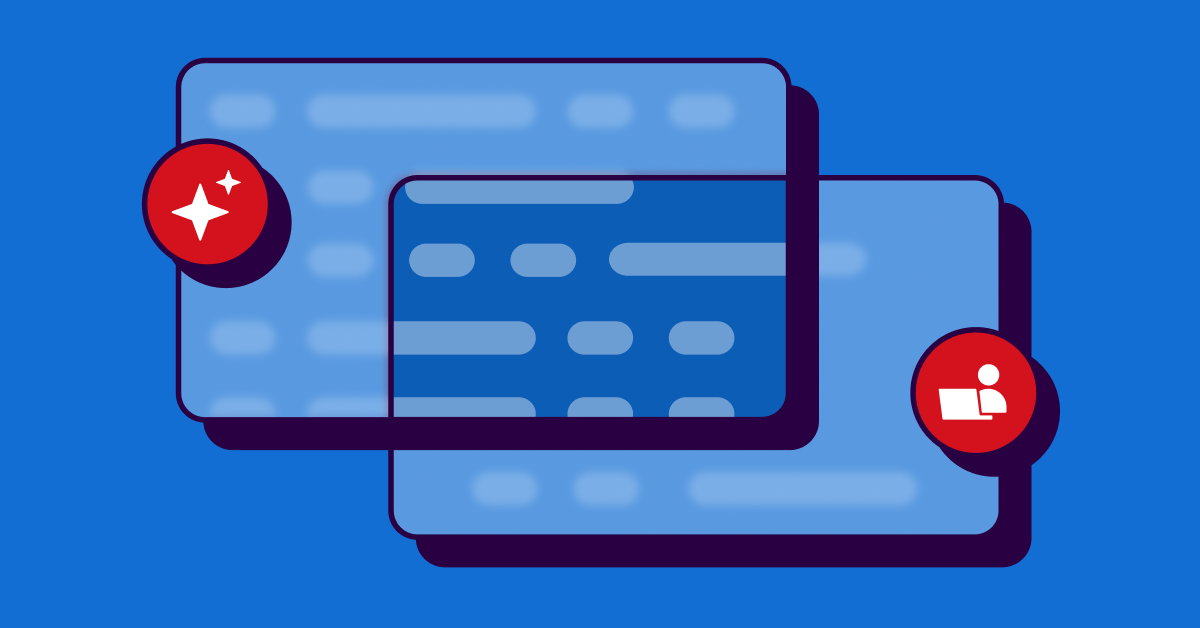Team Code reviews are essential to the development process. They ensure that the code meets the required standards before being merged into the main branch. They also help share knowledge by informing team members about the new changes made and the software development techniques employed during the implementation.
With the adoption of AI-generated code, reviews are becoming even more critical in the SDLC. Code assistants create an increasing amount of code that developers must carefully review to avoid security, performance, or execution errors.
This article shows the clear need for using tools like SonarQube to enhance the speed and security of code reviews while increasing developer confidence.
The Growth of AI-Generated Code
AI-generated code is growing rapidly in all projects’ code bases. For example, CEOs from Google and Meta are heavily investing in it internally and recently claimed that AI generates 25% of their new code or that AI will do the job of a mid-level engineer. To help create that amount of code, companies have introduced a new tool in their SDLC: the code assistants. They can help developers by suggesting code snippets, functions, and entire classes. While this can significantly speed up development, it also introduces new challenges:
- Code Quality: AI-generated code may not always follow best practices or coding standards.
- Security: AI models might introduce security vulnerabilities.
- Consistency: AI-generated code tends not to be consistent with the rest of the codebase.
The Role of Code Reviews
Code reviews are essential for maintaining code quality and security. They involve examining the code by one or more developers who provide feedback and suggest improvements or fixes. The primary goals of code reviews are:
- Identifying Bugs: Catching bugs early in the development process.
- Ensuring Code Quality: Following agreed-on coding standards and best practices.
- Enhancing Security: Identifying and mitigating potential security vulnerabilities.
- Knowledge Sharing: Promoting knowledge transfer among team members.
While these are very positive outcomes, they could also add anxiety to the SDLC by exposing the issues introduced to the team of reviewers and serving as a space for dysfunctional collaborations.
The Problem with Traditional Code Reviews
For large and distributed teams, code reviews can present several challenges:
- Time-Intensive: Reviewers spend considerable time identifying issues such as code smells, security vulnerabilities, and adherence to coding standards.
- Inconsistencies: Human reviewers may have varying experience levels, leading to subjective feedback.
- High Cognitive Load: Reviewing large pull requests with hundreds of lines of code can overwhelm even the most experienced developers.
- Delayed Feedback: Waiting for a code review can slow the development pipeline, impacting delivery timelines.
These pain points make it clear: teams need smarter tools to assist with the heavy lifting of code reviews.
Using good manners during Code Reviews will help teams reach their full potential and reduce friction and anxiety. Even after using “good manners” to have healthy pull requests, the code review will still raise awareness of the issues among the reviewers, as this is the natural goal of the pull request.
While this is positive in fixing the issues, it can also harm developer confidence if the issues are easy to spot, require fundamental knowledge, or simply the developer lacks attention to detail.
Team Code Reviews should focus on issues requiring broader knowledge from peers with more experience or profound knowledge of specific areas (performance, security).
Enhancing Team Code Reviews with Tooling
The key to having healthy and productive reviews is to use tools that explain the scope and check, warn, and even suggest fixes to avoid adding easy-fix issues to the code reviews. These tools will increase developer confidence and save time for the team with faster code reviews.
The proposed flow would be:
- Code the feature using an IDE
- Automatic analysis while coding (linter IDE plugin)
- Fix the highlighted issues
- Commit changes
- Open a PR to have the Team Code Review
- Use AI Agents to clarify the scope and give further explanation of the code
- Review the changes with the review team and suggest changes (loop)
- Try the merge to the main branch (involves an analysis and Quality Gate check)
In the quality aspect of a Code Review, when used from the very beginning of the SDLC, tools like static analyzers will check the code directly from the IDE and will help avoid code quality issues from slipping into the code. They also perform a complete analysis of the branch containing the changes, giving complete details of the issues found, the test coverage, and the quality rating of the new code.
With this process, developers can be sure that when they code, a tool warns them about the issues introduced. Directly from the IDE or later, with all the changes pushed to a branch, they can fix all the detected issues and learn from them before sending the code to be reviewed by their peers.
SonarQube is a powerful tool that can significantly enhance the code review process. It provides continuous code quality and security inspection, offering detailed insights and actionable feedback.
In addition to the personal confidence given to the developer before submitting the changes to a Code Review, SonarQube can boost the review process by providing the code analysis results showing the code quality issues and, for some of them, even suggesting the correct change generated by AI. This process of involving an analysis tool allows the reviewing team to focus on providing value from their expertise.
Another important part of a Code Review is the scope. Often a developer needs to review code that involves knowing the different parts of the code base that are used in the changes. Usually, this would involve pulling the changes to an IDE, reading the needed docs and tickets, and reviewing the code, and SDKs used. Fortunately enough, AI is also bringing Review Agents that will traverse the code base and other elements of the company knowledgebase (docs, issue trackers, etc) and will explain what the PR is potentially doing.
Here’s how SonarQube can help:
- Automated Code Analysis: SonarQube automatically analyzes code for bugs, code smells, and security vulnerabilities. This analysis identifies potential issues early, reducing the burden on human reviewers.
- Consistent Standards: By enforcing coding standards and best practices, SonarQube ensures that AI-generated code is consistent with the rest of the codebase.
- Security Insights: SonarQube provides detailed security analysis, helping to identify and mitigate vulnerabilities introduced by AI-generated code.
- Actionable Feedback: SonarQube offers clear, actionable feedback, making it easier for developers to address issues and improve their code.
Conclusion
Integrating AI-generated code into the SDLC process presents opportunities and challenges. By using tools like SonarQube, teams can enhance the speed and security of code reviews, ensuring that AI-generated code meets the highest quality and security standards. Early detection and warning about issues also boost developers' self-confidence. Combining human expertise and automated tools will be key to maintaining robust and secure codebases as software development evolves.

